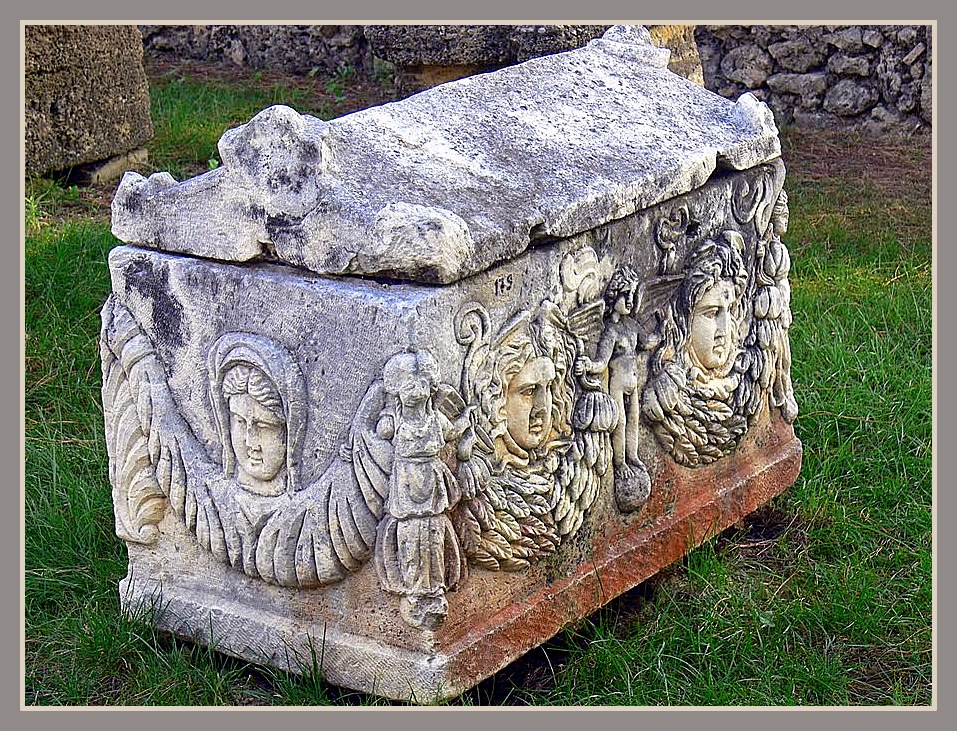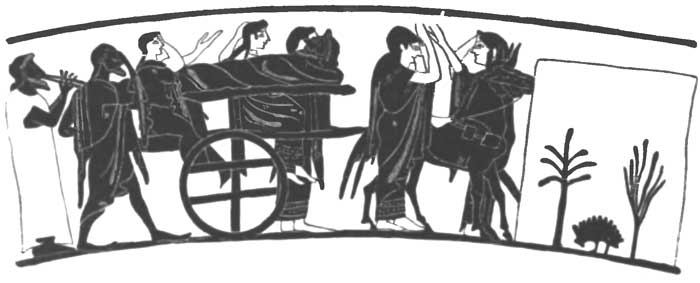
Greening Death
Reclaiming Burial Practices and
Restoring Our Tie to the Earth
Suzanne Kelly
(Rowman & Littlefield)

- In the United States, we use up 4,300,000 gallons of embalming fluid each year for burials.
- We also use 20,000,000 board feet of hardwood and 64,000 tons of steel each year for our caskets.
- In one cemetery study, geologists found concentrated levels of iron, lead, copper, zinc and cobalt in the silt loam, "all commonly used in casket construction."
- American crematories release "a range of by-products via fossil fuel combustion, including dioxins, hydrochloric acid, hydrofluoric acid, sulfur dioxide, carbon dioxide, nitrogen oxides, carbon monoxide, particulate matter, mercury, hydrogen fluoride, hydrogen chloride, and other heavy metals."
- The American "death care industry" is, according to the author, a "15-billion-machine molding American death rites."
- Contrary to the commonly held belief that funeral preparation protects us from disease and germs, "the Centers for Disease Control (CDC) suggest embalming could actually exacerbate the spread of some infectious diseases, particularly Ebola."
- One funeral practice that continues in many other nations is "open-air pyre burning." But there is only one place that it is permitted in the United States: Crestone, Colorado.
After you cack, if you wish, in some states, they allow you to be frozen, scrambled, pressurised, liquified and/or homogenized. Then your family can just pour you down the drain . . . or even let you or what's left of you be used (literally) for pushing up the daisies.
It is the "EATR" (Energetically Autonomous Tactical Robot), a "process that uses lye and heat to dissolve a body within a chamber. The liquefied remnants are then returned to sewer systems or used as fertilizer." EATR is a flesh-eating robot created by Robotic Technologies and funded by the U. S. Department of Defense," and is described in detail in Wired Magazine July of 2009 under the title of Military Researchers Develop Corpse-Eating Robots. Greening Death is chock-a-block filled with such details.
§ § § The book was originally inspired by the notion that, after the death of her father, author Kelly was distraught because she did not feel a part of the funerary procedure. Others took possession of his remains immediately after death, and she became an outsider to the whole process. "Dead bodies are kept in morgues and transported to funeral homes, and often buried or cremated out of sight of the bereaved," she writes. Her natural grief was thwarted. It "felt like a kind of nonaction, a recurring derailment." She was not part of the process, was dispossessed of her entitlement . . . the natural feelings of loss, regret, sadness.
Worse, her father's body had been "contaminated, poisoned." His blood was drained and the body was injected with chemicals, placed in an impermeable casket which was then encased in a reinforced concrete vault to be stuck in the ground. (In some cases --- the face of the deceased is powdered and painted, cotton stuffed in the jaw cavity which is then wired together. The body may even be dressed in special interment clothes, with special one-time one-user shoes).

Her final reaction to her father's funeral arrangements:
His body had, in all practical ways, become a problem. It seemed the most sinister of reversals. What kept my mind on the body were these facts. What plagued me wasn't simply the lack of cultural proximity of the dead, but, also, the dead body's distance from the whole of nature.
She hadn't only lost her father, she had also lost out on the whole process of familial and personal mourning. This loss started her on the investigation and insights about the (relatively) new idea of making death and the last rites into an organic, earth-enhancing, family-involved progression.
§ § § Ms. Kelly wants to influence us to return to the indigenous funerary practices of centuries past. She is a persuasive writer, and she certainly has my vote.
It is also apparent that she has a difficult road to hoe. The death biz is a $15,000,000 industry that has been using our fear of mortality to insulate us from the steel door down there awaiting all of us. The funerary industry owners are not going to release their iron grip gracefully. They carry in their back pockets most state, county and local governments who have engraved in stone onerous laws to protect them from any loss of revenue, and their oligopoly status. In 1963 in her bookThe American Way of Death, Jessica Mitford attempted to ridicule an industry "where bodies are superpreserved and then posed with props" but Kelly has found that so many years later, little has changed.
With one exception. The shift now is away from traditional burial rites. In American, almost fifty percent of "bodily disposals" are now by cremation . . . but the funeral businesses have responded, even figured out how to cash in on this new passion for cremation.
The average cost of a traditional burial runs about $7,700, according to a series of national television news programs from NBC concerned with the high cost of dying. Cremations, it reported, can be cheaper . . . including a "rental casket with removable liner," or, if you choose, "visitations and viewings or memorial services" --- but these can come close in price to a "regular" funeral.
Reporter Tyler Mathisen revealed that "If you keep it simple . . . the average cost of a cremation, including a basic memorial service, runs about $1,600." If you go for a so-called direct cremation, without a memorial service, the cost can drop below $1,000. Go online and you can find prices as low as $600.
§ § §
In her search to reconnect, Ms. Kelly discovered the concept of a "green death." She defines this as caring for the dead in a way that the impact of the newly dead on the earth will be in every way minimal. "Green burial grounds are on the rise in the United States, hovering somewhere around one hundred at last count."
In all of them, rain, wind and sun are respected in the world of decomposition, as well as the pressure of earth, stone and roots. Human decay is regarded as good and valuable, as microbes and insects descend to feed on the dead. As food and nourishment for other creatures, the corpse is of consequence to the land and to the species of mammals, birds, amphibians, plants and insects that inhabit it.
"In essence, the corpse [becomes] of consequence to the planet."
Any way you look at it, the sheer numbers in dying now may be getting out of hand. Consider how many bodies that have had to be disposed of over the period of man's habitation of the earth. First, we have to fix a time when the human race actually came into being, but it is not a straightforward matter.
Hominids walked the Earth as early as several million years ago. According to the United Nations' "Determinants and Consequences of Population Trends," modern Homo sapiens may have appeared about 50,000 B.C. This long period of 50,000 years holds the key to the question of how many people have ever been born. And popped off.
Using this figure as our starting point, the Population Reference Bureau estimates that 107,602,707,791 people have been born (at least, since the very act of being born was discovered). The population of the world is now around 7,000,000,000. That means that we have had, over the eons, to find burial space for more than a hundred billion people. That's 100,000,000,000. This death business does occupy a fair amount of real estate.
We suspect that people are not going to stop having babies. Nor are the rest of us going to go away (unless we manage to choke, freeze, bake, boil, broil, or fry ourselves en mass over the next few decades).
All this means that changing this die-and-dump-in-the-ground (or turn to smoke) business might be worth altering.
Other customs in other lands might be a help for us to ameliorate our own current practices. In South Korea, for example, a law passed in 2000 requires anyone burying a loved one to remove the remains after 60 years.
Or, perhaps more practical, there is exposure to the elements. According to Wonderslist, "many Vajrayana Buddhists in Mongolia and Tibet believe in the transmigration of spirits after death,"
that the soul moves on, while the body becomes an empty vessel. To return it to the earth, the body is placed on a mountaintop, which exposes it to the elements --- including vultures. It's a practice that's been done for thousands of years and, according to a recent report, about 80% of Tibetans still choose it."
§ § § Greening Death is a noble book, reminding us of the simple, often heartfelt rites of centuries past. The author repeats the fact of the mask of funerals as a form of "sanitization." There are alternative fluids, we are told, for enbalming "made of essential oils that pose no risk to worker health --- in one case, called 'Enigma.'" She also reminds us that, as a barrier to new green funerals, some states require at least $250,000 to bond initial funeral companies (although there may be special rates for small organisations). She observes that areas dedicated to green funerals may be perfect for rehabilitating "lands harmed through the likes of industrial farming, mining, sprawl, oil spills, mountain top removal [and] clearcutting."
The text does tend at times to wander about in circles, reviewing, several times, for instance, the focus of "green" funeral organizations around America, pointing out differences in their orientation, reminding us that --- for instance --- we may find more user-friendly death celebrations in other parts of the world.
Those of us who have been to India have sometimes chanced yikes upon pyres along the Ganges where bodies, covered in a simple white cloth, are soaked in ghee, set ablaze, and allowed to simmer over easy a couple of hours; the ashes are then sprinkled in the river. (There are videos of this on YouTube. If you are feeling brave, and have a little time to kill, you might participate. With an appropriate drink in hand. À votre santé!) This act of immolating the dead may well be the solution, a necessary space-saving device, especially in a country as bunched up, with the quick and with the mortified, as India.
Or, at worst, we can always avail ourselves of the elegant technique that appeared in Gulliver's Travels, where the Lilliputians were said to have buried their dead upside down:
They bury their dead with their heads directly downward, because they hold an opinion, that in eleven thousand moons they are all to rise again; in which period the earth (which they conceive to be flat) will turn upside down, and by this means they shall, at their resurrection, be found ready standing on their feet. The learned among them confess the absurdity of this doctrine; but the practice still continues, in compliance to the vulgar.